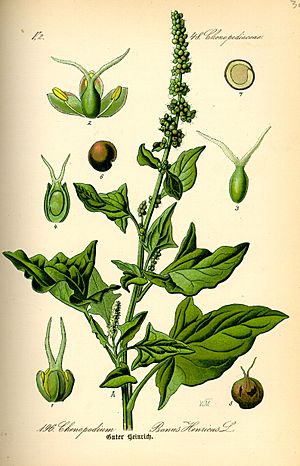Good-King-Henry facts for kids
Quick facts for kids Good-King-Henry |
|
|---|---|
 |
|
| Scientific classification | |
| Genus: |
Blitum
|
| Species: |
bonus-henricus
|
| Synonyms | |
|
see text |
|
Blitum bonus-henricus (also known as Chenopodium bonus-henricus) is a plant with many names! People call it Good-King-Henry, poor-man's asparagus, perennial goosefoot, and Lincolnshire spinach. It grows naturally in many parts of central and southern Europe.
For hundreds of years, Good-King-Henry was a popular vegetable grown in small home gardens. It's a plant that can be used for two things: food and sometimes as a weed. Today, it's not grown as much as it used to be.
Contents
What Good-King-Henry Looks Like
This plant can be an annual (meaning it lives for one year) or a perennial plant (meaning it lives for many years). It can grow quite tall, reaching about 40 to 80 centimeters (1.3 to 2.6 feet).
Its leaves are about 5 to 10 centimeters (2 to 4 inches) long and wide. They are shaped like a triangle or a diamond. Near the bottom, each leaf has two wide, pointed parts. The leaves feel a bit waxy and juicy.
The flowers grow on a tall, almost leafless spike that is 10 to 30 centimeters (4 to 12 inches) long. Each flower is very small, only about 3 to 5 millimeters (0.1 to 0.2 inches) across. They are green and have five sepals (leaf-like parts that protect the flower). The seeds are reddish-green and about 2 to 3 millimeters (0.08 to 0.12 inches) wide.
How Good-King-Henry Got Its Name
The scientific name for this plant was first given in 1753 by a famous scientist named Carl Linnaeus. He called it Chenopodium bonus-henricus.
For a long time, this plant was grouped with other plants in the Chenopodium family. But in 2012, scientists used new genetic research to study plants. They found that Good-King-Henry isn't actually a true Chenopodium.
It turns out this plant is more closely related to the Spinacia family. So, it was moved to a different group called Blitum. The scientific name Blitum bonus-henricus was first used by Ludwig Reichenbach in 1832.
Growing and Using Good-King-Henry
If you want to grow Good-King-Henry, you should plant it in a sunny spot. The soil should be rich and free of other weeds that come back every year.
The seeds need to be kept cold for a while before they will sprout. This is called "cold-stratification." Once planted, you should regularly remove weeds around the plants and make sure they get enough water. Usually, the plant doesn't produce much in its first year. Good-King-Henry also doesn't like to be moved once it's planted.
In the autumn, you can cut back the foliage (leaves) of the plant. Then, you can add a layer of leaf mould or well-rotted compost to the soil. This helps feed the plant for the next year.
Cooking with Good-King-Henry
You can start harvesting Good-King-Henry in the spring. Some of the new shoots that appear from mid-spring to early summer can be thinned out. These young shoots can be cooked and eaten just like asparagus. After you've taken some shoots, you should stop cutting so the plant can grow bigger.
The juicy, triangular leaves can be picked a few at a time until the end of August. These leaves can be cooked and enjoyed just like spinach.
Gallery
See also
 In Spanish: Espárrago del Rey Enrique para niños
In Spanish: Espárrago del Rey Enrique para niños




